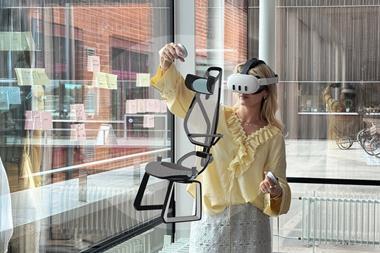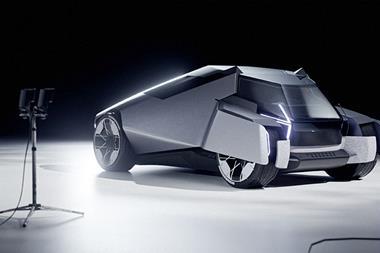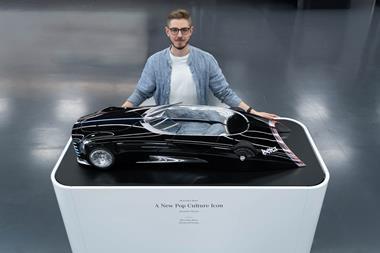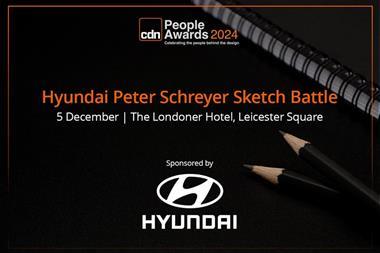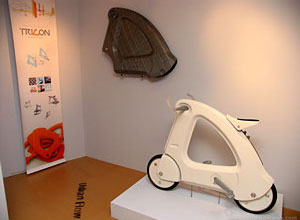

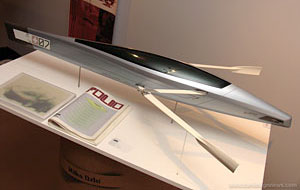
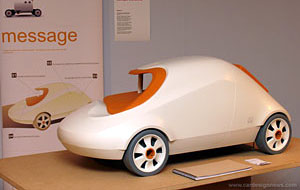
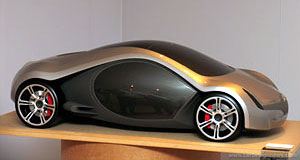

'Panta Rei' by Tobias Nagel is a mobility system of floating spaces aimed at optimizing the use of metropolitan waterways, 'liquefying city structures'. It represents a scenario for connecting people with places by adding a new layer of flexible infrastructure to the metropolis, utilizing waterways in in mega-cities such as Tokyo and London to accomodate a system of floating spaces, for residential or business purposes. Provided by vehicle manufacturers, the rentable floating accomodation would enable individiuals or young couples to be in the right place at the right time, reducing unnecessary movements in the cities, and extending personal freedom by saving time otherwise spent in traffic. Residents would also be provided with a small electrically powered amphibious vehicle, for connection with the floating units, and short trips around the city.
U-Scull by Milko ?zlu is a new type of human-powered sports-submarine that operates in shallow depths. Two users propel its oars by a sliding seat mtion similar to that of sculling. With a scuba license and a short introduction course, the passebgers are ready to hit the water. Milko explains: "Rowing is a widely known as a sport that uses the full output of the human body. With a sliding seat motion, simple mechanics, and a shark-like skin, two people can power the submarine at 8-9 knots."
lvaro Del Campo's 'Message' concept explores a new form language where the interior elements of the car feature as part of the exterior design, seemingly impacting the interior components with the exterior.
Alvaro explains: "The aim of this project was to find a contemporary language for vehicles which is more expressive, and therefore more accessible to people".
Serge Porcher presented two concepts under the theme 'Fashion4cars': a fashionable Citro?n and a coat for the Austin Mini. "Globalization and internationalisation have caused a decrease in independent automotive manufacturers and a rise in the variety of vehicle types. The key differentiationg factor is now visual appearance. A car's removable outer skin could provide style, status and flexibility as well as protection, warmth and safety."
'Flow' by Tiago Dias is a rental vehicle designed to be available to tourists that travel to Portugal with the intent of experiencing the country at a deeper cultural and social level. Drawing on the concept of 'slow food' that represents the slower pace of life in southern Europe, the vehicle would explore the wonders of slow travelling, and provide the users with an incentive to make the most of the journey, as they travel between the government-sponsored inns spread across the country.
Gareth Thomas proposed a new approach to the hydrogen fuel-cell powered vehicle designed to capture the public imagination. "In their present form cars are destroying life, but a fuel cell car has the potential to actually nurture it, in particular plant life, feeding it with its harmless waste product: water. Urban environments would benefit from the added beauty of organic life contained in moving transparent sculptures.
Zen Box by Dimitris Zacharopoulos deals with duality, a major characteristic of Japanese culture and lifestyle. The concept utilizes the potential value of unused space in modern cities - the parked commercial vehicle. By incorporatin gelements of nature into the interior, the aim is to reduce levels of stress, providing a 'Zen-like' space, separate from the outside chaos. It would be a part commercial, part public service vehicle, providing 24 hour service bookable via the internet. Aesthetically th exterior is influenced by Japanese woodcraft techniques, with a corrugated structure reflecting security for both parcel and occupant.
The RCA Vehicle Design department, which is supported by many major automotive manufacturers, aims to develop the student's creative, intellectual and critical potential. "Our fundamental aims are to provide a learning environment that stimulates students to go beyond their expectations and become first class designers" explains Dale Harrow, head of the Vehicle Design department. "Research abilities, understanding the future implications of their designs, and taking social responsibility for their work are essential elements of a Vehicle design student's journey."
The models, drawings, video and interactive presentations shown provide a narrative of the design process, showing how research meets design concept and both emerge in creative studio practice. Central to the course methodology is the understanding of the broader issues of vehicle design necessary to optimize opportunities for mobility. Students are expected to develop an awareness of the range of issues that affect mobility including accessibility, aerodynamics, environmental impact, ergonomics, legislation, materials, production, safety and technology, as well as aesthetic principles.
The MA curriculum is structured around three themes:
Urban Flow - concentrating on providing advanced inclusive mobility, moving people and/or goods within specific urban environments, improving vehicles and systems.
Inside Out - Focussing on the vehicles materials, production and manufacturing technologies, considering in particular the functional design of vehicle interface with the user.
Automark - exploring strategic design solutions, creating innovative vehicle concepts that provide significant value to a business, identifying and creating new commercial and brand potential.
The course has students from a wide range of cultural and professional backgrounds, with many coming from non-automotive fields of design. The department has expanded it's research programmes, with students studying for both MPhil and PhD qualifications within the MA studio environment.

































